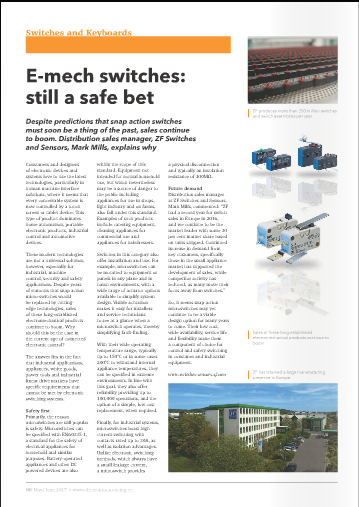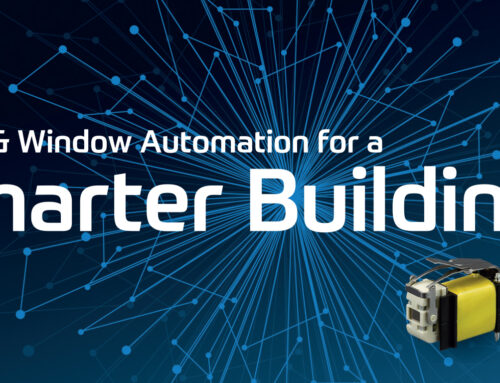Mark Mills, Distribution Sales Manager – ZF Switches & Sensors
Consumers and designers of electronic devices and systems are alike in their desire to have access to the latest technologies. None more so than in the arena of HMI (human machine interface), it seems that every conceivable system is now controlled by a touch screen or tablet device. They dominate home automation, portable electronic products, industrial control and automotive devices.
However, these new technologies are not a universal solution for industrial, machine control, security and safety applications. Despite years of rumours that snap action microswitches would be replaced by cutting-edge technologies, sales of these long-established electromechanical products continues to boom. Why should this be so in the current age of connected electronic control?
Industrial applications, appliances, white goods, power tools and industrial linear drive markets have specific requirements which cannot be met by electronic switching systems. The main reasons include;
Safety – a prime concern for any system designer. Microswitches can be specified with EN60335-1, a standard for the safety of electrical appliances for household and similar purposes. Battery-operated appliances and other DC powered devices are also within the scope of this standard. Equipment not intended for normal household use but which nevertheless may be a source of danger to the public including appliances intended to be used by people in shops, light industry and on farms, are also within the scope of this standard. Examples of such these products include catering equipment, cleaning appliances for commercial use and appliances for hairdressers.
Ease of mounting – microswitches may be mounted to equipment or panels in any plane and in harsh environments. A wide range of actuator options simplifies system design.
Visible actuation – installers and service technicians can see at a glance when a microswitch operates, simplifying fault-finding.
Wide operating temperature range – typically up to 150°C and in some cases 200°C to withstand internal temperatures of appliances.
Reliability and cost of ownership – up to 100,000 operations are possible with simple and low cost replacement if required.
High current switching – contacts can be rated up to 30A for industrial systems.
Isolation – electronic switching methods always have a small leakage current unlike a microswitch with a physical disconnection and typically an insulation resistance of 100MΩ.
”ZF had a record year for switch sales in Europe in 2016, and we continue to be the market leader with some 30% market share based on units shipped.” Mark Mills, Distribution Sales Manager at ZF Switches and Sensors, comments, ”Continued increase in demand from key customers, specifically those in the small appliance market has supported the development of sales, while competitor activity has reduced as many move their focus away from switches.”
Snap action microswitches will continue to be a viable design option for many years to come. Their low cost, wide availability, service life and flexibility make them an indispensable component of choice for control and safety switching requirements in consumer and industrial equipment.
ZF, formerly CHERRY, has more than 60 years of experience in the switch business and produces more than 250 million switches and switch assemblies per annum.
ZF is one of the few manufacturers that has retained a large manufacturing presence in Europe, producing parts in Auerbach, Germany, and across the border in Klasterec, Czech Republic.
For more information on switch and sensor solutions from ZF Switches & Sensors visit www.switches-sensors.zf.com









